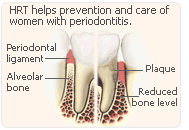
A great deal of evidence suggests that a lack of estrogen hormones affects periodontal tissues and may play a part in the development of periodontitis in postmenopausal women, separate from the influence of insufficient estrogen hormones on alveolar bone. The information below discusses this in greater detail, focusing on the role of hormone/estrogen hormones replacement therapy (H/ERT).
Throughout menopause and afterwards, the link between estrogen hormones deficiency and tooth loss is usually explained by a series of events started either by alveolar bone loss speeded up by a shortage of estrogen hormones or by periodontitis. Loss of alveolar bone in post-menopausal women results in, among other things, retracting gum margins, and development of periodontitis.
The impact of reduced levels of estrogen hormones directly on alveolar bone in post-menopausal women does not fully explain the relationship between a lack of estrogen hormones and tooth loss. A lot of reviews have indicated a positive influence of estrogen hormones directly on periodontal tissues, despite the fact that this concept is not discussed in current reviews of risk factors for periodontal disease in post-menopausal women.

Around 30 years ago, tooth loss was more common among post-menopausal women with osteoporosis aged 60 to 69 years. Dr Daniell found that no post-menopausal woman had encountered tooth loss during the years in which she was using hormone/estrogen hormones replacement therapy (H/ERT), even if she had developed osteoporosis. This suggested relatively healthy dental soft tissues in post-menopausal women during hormone/estrogen hormones replacement therapy even with weakened alveolar bone.
Other investigations have noted diminished tooth loss in post-menopausal women using estrogen hormones, diminished gingival bleeding during estrogen hormones use even after controlling for other factors contributing to periodontitis in estrogen hormones-deficient post-menopausal women. Other studies have reported cure or prevention of gingival and periodontal disease during hormone/estrogen hormones replacement therapy. Such findings indicates a capability for hormone/estrogen hormones replacement therapy in the prevention and treatment of post-menopausal women with periodontitis.
A common trend continues to be nonsmoking post-menopausal women free of diabetes mellitus in their 50s and 60s with periodontal disease that greatly improves within a few months of starting systemic estrogen hormones therapy.
Dr Daniell brings to the attention of post-menopausal women the role of estrogen hormones deficiency as a risk for periodontal disease and ensuing tooth loss and use of hormone/estrogen hormones replacement therapy to prevent gum deterioration. Evidence linking estrogen hormones deficiency to risk of soft tissue disease comes from observational studies or findings in small groups. In order to fully understand the degree to which hormone/estrogen hormones replacement therapy is successful in averting soft tissue deterioration, a placebo-controlled, randomized trial is necessary. However, this trial would be difficult to put into practice given that it would require leaving participants with active periodontal disease untreated which is somewhat unethical.